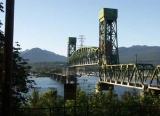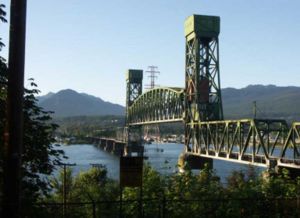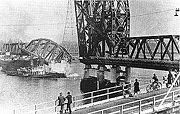
Second Narrows Bridge
Encyclopedia

Lift bridge
A vertical-lift bridge or lift bridge is a type of movable bridge in which a span rises vertically while remaining parallel with the deck....
railway bridge that crosses the Burrard Inlet
Burrard Inlet
Burrard Inlet is a relatively shallow-sided coastal fjord in southwestern British Columbia, Canada. Formed during the last Ice Age, it separates the City of Vancouver and the rest of the low-lying Burrard Peninsula from the slopes of the North Shore Mountains, home to the communities of West...
and connects Vancouver
Vancouver
Vancouver is a coastal seaport city on the mainland of British Columbia, Canada. It is the hub of Greater Vancouver, which, with over 2.3 million residents, is the third most populous metropolitan area in the country,...
with the North Shore
North Shore (Greater Vancouver)
"Vancouver's North Shore" is a term commonly used to refer to several areas adjacent to Vancouver, British Columbia, Canada:*the District of West Vancouver;*the City of North Vancouver;*the District of North Vancouver; and...
. As the name suggests, it is located at the second narrowing of the Burrard Inlet.
The original Second Narrows Bridge was constructed in 1925, and was the first bridge to connect Vancouver
Vancouver
Vancouver is a coastal seaport city on the mainland of British Columbia, Canada. It is the hub of Greater Vancouver, which, with over 2.3 million residents, is the third most populous metropolitan area in the country,...
with the North Shore over the tidal bore of the narrows. This bridge was constructed, by John Stewart
John Stewart (financier)
John Stewart was a Canadian financier and railway builder.He was born in Nedd, Assynt, Sutherland, Scotland on 4 Dec 1860; died 24 Sep 1938 Vancouver, British Columbia, Canada....
and Northern Construction, with a car deck and a year later in 1926 trains began using the bridge as well. After being hit by a number of ships and being out of service for 4 years, in 1933 the provincial government bought the bridge and installed a lift section of the deck
Deck (bridge)
A bridge deck or road bed is the roadway, or the pedestrian walkway, surface of a bridge. It is not to be confused with any deck of a ship.The deck may be of concrete,wood which in turn may be covered with asphalt concrete or other pavement...
.
In 1960 a new much larger (350 m, 1,150 ft, span) and higher 6 highway lane Second Narrows Bridge was completed alongside the original bridge, and the original bridge was converted exclusively for rail use. In 1994 the new bridge was renamed the Ironworkers Memorial Second Narrows Crossing
Ironworkers Memorial Second Narrows Crossing
The Ironworkers Memorial Second Narrows Crossing, also called the Ironworkers Memorial Bridge, is the second bridge constructed at the Second Narrows of Burrard Inlet in Vancouver, British Columbia, Canada...
in honor of the ironworkers who died in accidents while building it. However, the new bridge is still commonly referred to as the Second Narrows Bridge.
The 1926 railbridge was replaced in 1969 with a larger, higher lift bridge. A bridgetender activates cables
Wire rope
thumb|Steel wire rope Wire rope is a type of rope which consists of several strands of metal wire laid into a helix. Initially wrought iron wires were used, but today steel is the main material used for wire ropes....
and counterweight
Counterweight
A counterweight is an equivalent counterbalancing weight that balances a load.-Uses:A counterweight is often used in traction lifts , cranes and funfair rides...
s to raise the span. Unless moving a train across the Burrard inlet, the lift section is always in the up position to allow ships to go underneath. The Lions' Gate Bridge
Lions' Gate Bridge
The Lions Gate Bridge, officially known as the First Narrows Bridge, is a suspension bridge that crosses the first narrows of Burrard Inlet and connects the City of Vancouver, British Columbia, to the North Shore municipalities of the District of North Vancouver, the City of North Vancouver, and...
spans the first narrows of Burrard Inlet.
Background
Amid the hullaballoo of the Klondike Gold RushKlondike Gold Rush
The Klondike Gold Rush, also called the Yukon Gold Rush, the Alaska Gold Rush and the Last Great Gold Rush, was an attempt by an estimated 100,000 people to travel to the Klondike region the Yukon in north-western Canada between 1897 and 1899 in the hope of successfully prospecting for gold...
were schemes to build a railway from Vancouver to the Dawson
Dawson City, Yukon
The Town of the City of Dawson or Dawson City is a town in the Yukon, Canada.The population was 1,327 at the 2006 census. The area draws some 60,000 visitors each year...
gold fields. Of course the first stage in this would be to bridge Burrard Inlet and then build a railway north. John Hendry floated the Vancouver, Westminster, and Yukon Railway which built a line from Ladner to Westminster and then to Vancouver via Burnaby Lake. This line was paired with the Great Northern Railway who also wanted trackage into Vancouver.
In the process, various other railroads all became involved in the bridging scheme: the Canadian Northern Railway
Canadian Northern Railway
The Canadian Northern Railway is a historic Canadian transcontinental railway. At its demise in 1923, when it was merged into the Canadian National Railway , the CNoR owned a main line between Quebec City and Vancouver via Ottawa, Winnipeg, and Edmonton.-Manitoba beginnings:CNoR had its start in...
, Milwaukee Road, and the Pacific Great Eastern Railway. The bridge itself would be owned by the Federal Government as they had control of harbours and shipping, and would lease access to the railways as they did with the rail bridge in New Westminster. One of the main reasons was that there was very little space on the south shore for wharves, thus railways wanted to develop the North Shore. The south side was occupied by another railway. A company was floated, the Burrard Inlet Bridge and Tunnel Company, and contracts were issued to span the tidal bore. A one point, a causeway was planned to dam the narrows and create bridges and wharves that way.
Alas, World War I
World War I
World War I , which was predominantly called the World War or the Great War from its occurrence until 1939, and the First World War or World War I thereafter, was a major war centred in Europe that began on 28 July 1914 and lasted until 11 November 1918...
intervened, as did the bankruptcy of all the interested railways. With it went dreams of the bridge and rails up Indian Arm, Capilano, or Howe Sound. However, the predecessor railways did sign contracts to build
a bridge and a new Hotel Vancouver. Only after the war with huge increase in funding to improve harbours around the British Empire
British Empire
The British Empire comprised the dominions, colonies, protectorates, mandates and other territories ruled or administered by the United Kingdom. It originated with the overseas colonies and trading posts established by England in the late 16th and early 17th centuries. At its height, it was the...
, partly due to problems associated with wartime shipping, did funds appear for the completion of the 1925 bridge. And so the north shore port became an amalgam of operations with Canadian National, Pacific Great Eastern and Harbour and Wharves Commission all using the bridge when it was not out of service. North Vancouver ferries operated at this time as well.
The essential wartime shipyards in North Vancouver, underscored the need for reliable industrial access. Further,
the expansion of Lynnterm, Wheat elevators, coal and the sulphur port in the 1960s indicated the growing use
of the North Shore.
Chronology of the original bridge

- 1902 V. W. and Y Railway completed to Burnaby. Bridge Planned.
- 1910 Burrard Inlet Bridge and Tunnel Company plans floated.
- 1912 Land speculation on North Shore, subject to completion of bridge.
- 1914 Railway to Deep Cove and Port Moody planned.
- 1915 Market Collapse; P. G. E Railway bankrupt.
- 1916 Causeway planned; Canadian Northern bankrupt.
- 1925: A smaller, lower bridge is completed, than originally envisioned.
- 1926: Trains began using the bridge.
- 1927: A 10,000 ton freighter, the Eurana hit it on March 10 causing almost $80,000 worth of damage.
- 1928: Hit by the SS Norwich CitySS Norwich CityThe SS Norwich City was a British, oil-fired steam freighter powered by a triple expansion steam engine and manufactured in 1911 by Central Marine Engine Works in Britain.In 1928, the ship ran into the Second Narrows Bridge in Vancouver, B.C.....
. - 1930: The Losmar hits the south span.
- 1930: On September 13, the barge Pacific Gatherer becomes wedged under the bridge’s fixed centre span. The tide rose pushing the barge up under the span, knocking it off its supports. The span hung off one side before suddenly breaking free and sinking into the depths of Burrard Inlet. Lawsuits and the bankruptcy of the Bridge company delayed any attempt at repairs. The bridge remained closed for four years.
- 1933: Sold to the Provincial government. Repairs began.
- 1934: Reopened, replacing the bascule with a centre lift span.
- 1963: Closed to highway traffic and sold to the CNR for $1.
- 1968 New, larger lift bridge is built immediately to the east of the 1926 Bridge.
- 1969: Tunnel is dug for CN trains to connect with line at Willingdon.
- 1970 Old bridge is removed, as are cement piers.
External links
- A Short History of the Second Narrows Bridge
- Satellite image of the Ironworkers Memorial Second Narrows Crossing and Second Narrows Bridge
See also
- List of bridges in Canada
- Ironworkers Memorial Second Narrows CrossingIronworkers Memorial Second Narrows CrossingThe Ironworkers Memorial Second Narrows Crossing, also called the Ironworkers Memorial Bridge, is the second bridge constructed at the Second Narrows of Burrard Inlet in Vancouver, British Columbia, Canada...

